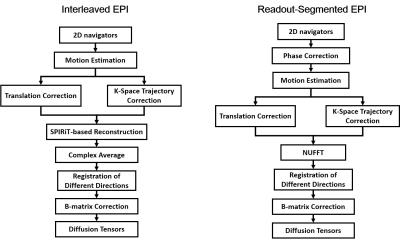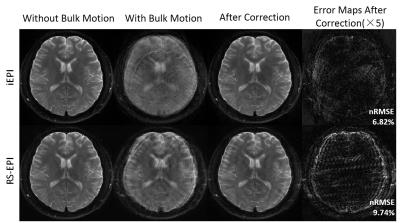1308
Comparison of Multishot Readout-Segmented EPI and Interleaved-EPI for Motion Correction1Center for Biomedical Imaging Research, Department of Biomedical Engineering, School of Medicine, Tsinghua University, Beijing, People's Republic of China, 2Harvard-MIT Health Sciences and Technology, MIT, Cambridge, MA, United States
Synopsis
Readout-segmented EPI (RS-EPI) and interleaved-EPI (iEPI) are the two most widely used multishot EPI techniques for high resolution DWI. Many methods have been proposed to correct the motion-induced phase variations and rigid-motion in RS-EPI and iEPI. To compare the performance of motion correction in RS-EPI and iEPI, DWI and DTI simulations were designed. The correction methods we implemented for RS-EPI and iEPI take account of motion-induced phase variation, bulk motion and altered diffusion gradient orientation due to rotation. In our test, iEPI show less artifacts, however the b-matrix correction of RS-EPI is more straightforward with better accuracy.
Purpose
Multishot-EPI techniques can improve the image resolution of diffusion imaging compared with single-shot methods. Readout-Segmented EPI (RS-EPI) and interleaved-EPI (iEPI) are the two most developed techniques in multishot-EPI. To correct for the motion-induced errors, phase variation and bulk motion correction methods have been developed for RS-EPI 1, 2 and iEPI 3-6. To compare the performance for motion correction using these two different sampling patterns quantitatively, DWI and DTI simulations are designed. The effects of motion-induced phase variation, bulk motion-induced blurring and diffusion gradient alternation are simulated. We develop the correction method for iEPI 5 and ameliorate the correction method by Samantha et al. for RS-EPI 2 with b-matrix rotation correction.Methods
In multishot EPI DWI, three kinds of errors need to be considered: (1) phase variations between different shots (segments) due to minuscule motion during the application of diffusion gradients, (2) bulk motion-induced blurring and artifacts, (3) the altered diffusion gradient orientation due to rotation. In this study, we compared the performance of 2D navigated RS-EPI and iEPI when bulk motion exists. The complete reconstruction process of both methods (Figure 1) take account of the above three motion-induced errors.
First, motion parameters including translation and rotation are estimated using the 2D navigators 7. For iEPI, the next step is to add linear phase to k-space to correct translation, and to rotate the sampling trajectory by estimated rotation angles to correct rotation. Then, multishot SPIRiT-based reconstruction 6 is used to reconstruct the corrected non-Cartesian data for phase variation correction 5. For b-matrix correction, the altered diffusion gradient is rotated using the estimated angle of the reference shot in each direction relative to the non-diffusion-weighted image. The reference shot along each direction is defined as the shot with the median rotation angle of all shots. For RS-EPI, the reconstruction process including phase correction and rigid-motion correction is based on the work by Samantha et al 2. After reconstruction of diffusion images, b-matrix correction is achieved by rotating the diffusion gradient vectors using estimated angles of the central segments.
One-Direction DWI Simulation A T2-weighted image was used to generate the multishot RS-EPI and iEPI data with motion. The effects of altered b-matrix was not included in this simulation. 8-channel-7-shot data was simulated and 2nd-order spatially varying random phases were added to different shots respectively to simulate the motion-induced phase variations. To simulate bulk motion, image of each shot was randomly rotated (0~40°) and translated (-5~5 pixels). Spatially uncorrelated Gaussian noise was added to k-space (SNR = 5). The matrix size was 210×210 and navigator size was 25×25.
DTI Simulation The DWI simulation above was expanded to simulate DTI data in which image contrast was altered by b-matrix rotation. 7-shot and 6-direction data with random phases, random bulk motion, altered diffusion contrast with rotated b-matrix were simulated. NSA = 3, b value = 800 s/mm2. Three quantitative parameters were used to assess the performance: 1) percentage error of FA (FAerr), 2) the angular deviation of principal eigenvector V1 ($$$\measuredangle$$$V1), 3) percentage error of mean diffusivity (MDerr).
Results
Figure 2 shows the reconstructed images by iEPI and RS-EPI in the DWI simulation. The images after bulk motion correction and the corresponding error maps validate that both methods can remove most artifacts induced by motion while iEPI performed better than RS-EPI with a lower nRMSE. The nRMSEs of iEPI and RS-EPI with different rotation angles in the DWI simulation are shown in Figure 3. The iEPI shows consistently lower nRMSEs than RS-EPI at all rotation angles. Results of DTI simulation are shown in Figure 4. In contrast to the DWI simulation, iEPI provided slightly higher FAerr and $$$\measuredangle$$$V1 than RS-EPI. The reason is that the b-matrix correction of iEPI is harder than RS-EPI.Discussion and Conclusion
DWI and DTI simulations validated that both iEPI and RS-EPI can correct for most motion-induced errors including phase variation, blurring and b-matrix rotation. Current tests show that the level of image artifacts in iEPI is lower than in RS-EPI because of the advanced reconstruction facilitated by parallel imaging. However, for the b-matrix rotation, the correction in RS-EPI is more straightforward, using the rotation information of central segment which contains more contrast information. One limitation of this study is that no in-vivo study was performed due to motion is hard to be controlled and duplicated in different scans. For practical concern, motion-corrupted data rejection can result in gaps in k-space for RS-EPI, thus the data-reacquisition is very necessary 2. In comparison, rejection-induced undersampling in iEPI can be compensated by the motion correction together with parallel imaging.Acknowledgements
This work was supported by Tsinghua University Initiative Scientific Research Program.References
1. Porter, D. and E. Mueller. Multi-shot diffusion-weighted EPI with readout mosaic segmentation and 2D navigator correction. In Proceedings of the 12th Annual Meeting of ISMRM. 2004.
2. Holdsworth SJ, Skare S, Newbould RD, Bammer R. Robust GRAPPA-accelerated diffusion-weighted readout-segmented (RS)-EPI. Magn Reson Med, 2009. 62(6): p. 1629-40.
3. Ma X, Zhang Z, Dai E, Guo H. Improved multi-shot diffusion imaging using GRAPPA with a compact kernel. Neuroimage, 2016.
4. Guhaniyogi S, Chu ML, Chang HC, Song AW, Chen NK. Motion immune diffusion imaging using augmented MUSE for high-resolution multi-shot EPI. Magn Reson Med, 2016. 75(2): p. 639-52.
5. Wang F, Dong Z, Ma X, Dai E, Zhang Z, Guo H. Motion-Corrected K-Space Reconstruction for High Resolution Multi-Shot Diffusion Imaging. In Proceedings of the 24th Annual Meeting of ISMRM. 2016. Singapore.
6.Dong Z, Wang F, Ma X, Dai E, Zhang Z, Guo H. A Robust Reconstruction Method for High Resolution Multishot DWI: SPIRiT-based SYMPHONY. In Proceedings of the 24th Annual Meeting of ISMRM. 2016. Singapore.
7. Pipe, J.G., Motion correction with PROPELLER MRI: application to head motion and free-breathing cardiac imaging. Magn Reson Med, 1999. 42(5): p. 963-969.
Figures



